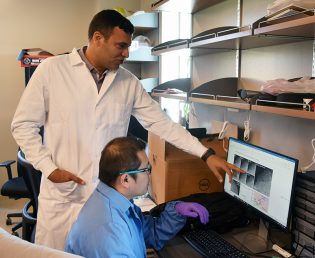Stabilizing single atoms at record-high temperatures in short durations
By David Stauacher
Efficiency is important in every industry and a group of engineers recently reported a breakthrough on the atomic synthesis of materials, which could be a game-changer for industries that use precious metals and chemical reactions.
Researchers from the University of Illinois at Chicago (UIC), University of Maryland (UMD), Johns Hopkins University, Argonne National Laboratory and the Pacific Northwest National Laboratory report using highly controllable, high temperature shockwaves to synthesize and stabilize single atoms at record-high temperatures. Their findings were published in the paper “High Temperature Shockwave Stabilized Single Atoms” in the journal Nature Nanotechnology.
“In this work, we utilized atomic-resolution STEM (Scanning Transmission Electron Microscopy) to demonstrate that single atoms could be become stabilized on substrate with a shockwave method. These single atoms can be excellent catalysts for electrochemical reactions,” said Reza Shahbazian-Yassar, professor of mechanical and industrial engineering in the UIC College of Engineering and a corresponding author of the paper.
The researchers have discovered that the stability of single atom catalysts against clumping is critical for practical applications. High temperatures can promote the strong binding of single atoms onto the substrate by forming metal-substrate bonds with enhanced thermal stability. They achieved this with a periodic on-off heating pattern with a short on-state and a 10-times longer off-state.
“The high temperature on-state promotes single atom dispersion and stabilization by forming strong metal-substrate bonds,” said Zhennan Huang, Ph.D. student at mechanical and industrial engineering in the UIC College of Engineering and a co-first author of the paper. “The off-state ensures stability by preventing overheating-induced atom clumping and deterioration.”
The shockwave method developed at UMD is simple, ultrafast and universal for producing thermally stable single atom dispersions and on different substrates, which opens a general route for single atom manufacturing that is conventionally challenging.
“This will have a major impact on multiple industries. It can be used for any application that uses precious metals or catalyze a chemical reaction,” Shahbazian-Yassar said. “It means that industry can produce this catalysts as small as possible. Whenever they have a clump of platinum they lose money, because platinum is expensive. For instance, in a fuel cell-powered car, the most expensive part of a fuel cell is the platinum, because they need to use a lot of it in the form of nano or micron size particles. Industry is looking for a way to reduce the catalyst as much as possible — especially expensive catalysts like platinum.”
When a catalyst is used for any application, it will be more efficient if the atoms are separated instead of aggregated together. The surface of the elements are doing the active job and catalyzing the reaction. If the elements are clumped together, some of the surface is lost and it is no longer helping in the reaction. The more surface that is available means the more chemical reaction will occur, which will increase productivity.
“The productivity or efficiency of a reaction goes significantly higher when single atoms are used,” he said. “We performed real-time microscopy to confirm these single atoms remain actually stable when exposed to high temperatures even after few hours on heating up to 1273 K. We would like to perform prolonged electron microscopy and spectroscopy studies on these stabilized single atoms when dispersed on other substrates rather than carbon fibers in order to further generalize this approach. It is fun to explore these exciting materials.”
Yonggang Yao of UMD, Zhennan Huang of UIC, Pengfei Xie of Johns Hopkins, Lianping Wu of UMD, Lu Ma of Argonne, Tangyuan Li of UMD, Zhenqian Pang of UMD, Miaolun Jiao of UMD, Zhiqiang Liang of UMD, Jinlong Gao of UMD, Yang He of the Pacific Northwest, Dylan Jacob Kline of UMD, Michael R. Zachariah of UMD, Chongmin Wang of the Pacific Northwest, Jun Lu of Argonne, Tianpin Wu of Argonne, Teng Li of the UMD, Chao Wang of Johns Hopkins, and Liangbing Hu of the UMD, are co-authors on the paper.
Shahbazian-Yassar is the director of the Nano Engineering Lab at UIC, where his team specializes in fundamental and nanoscale studies of materials for electrochemical energy storage, nanoelectronics, and healthcare applications.
Learn more about his research at http://nanoeng.uic.edu.

